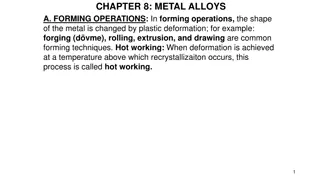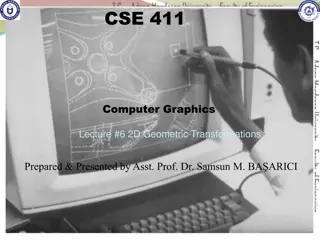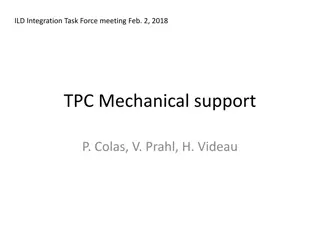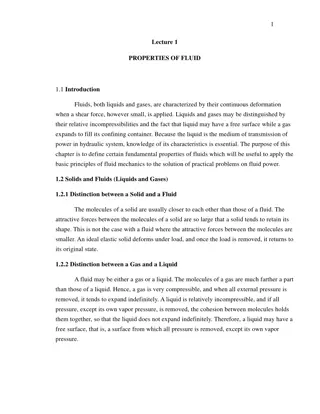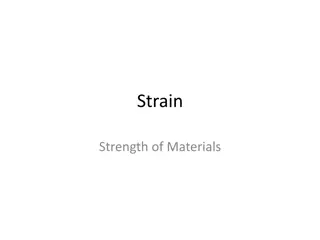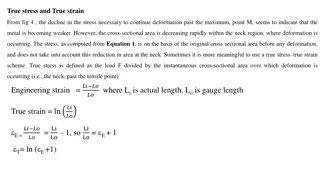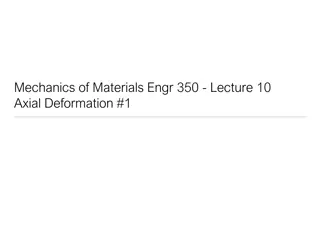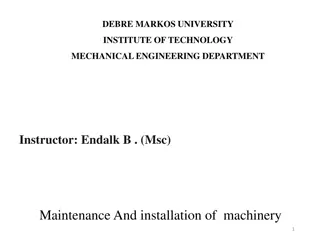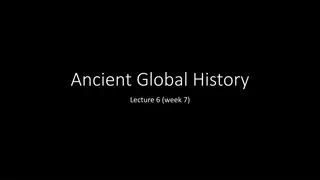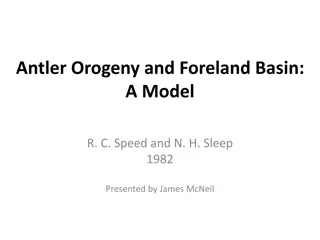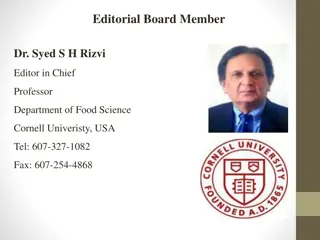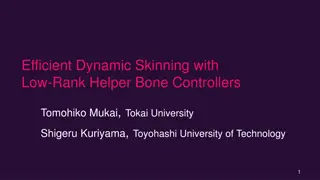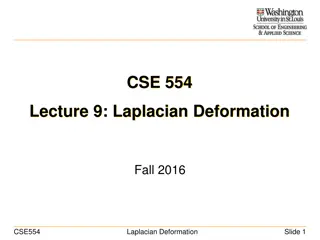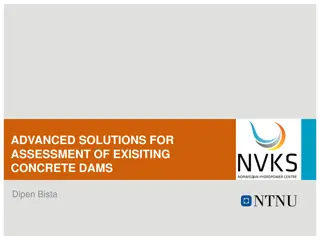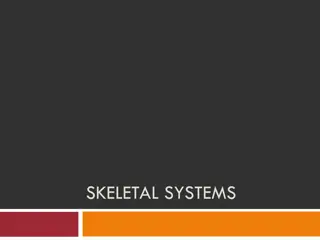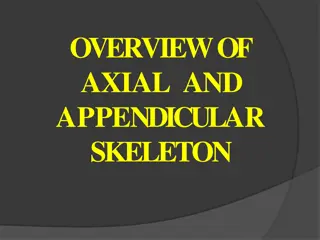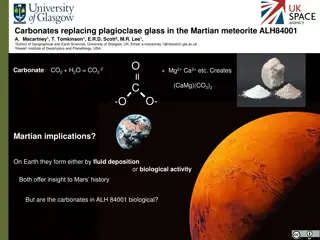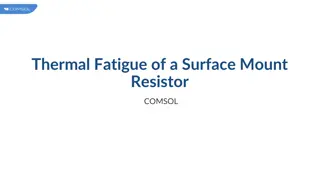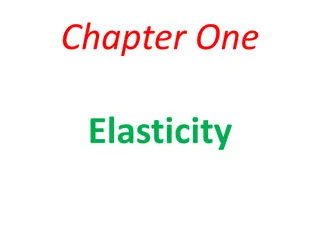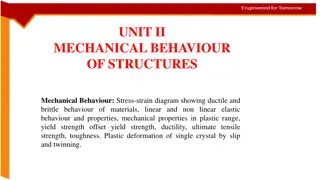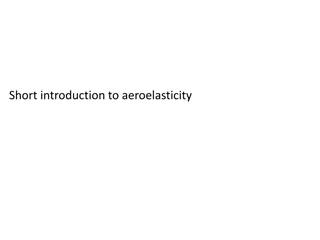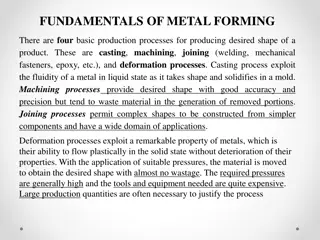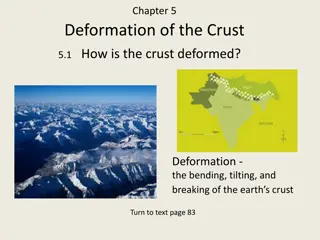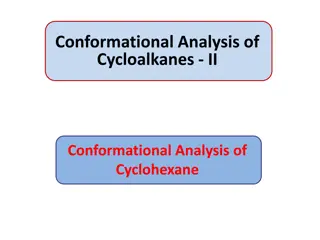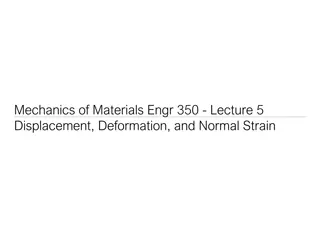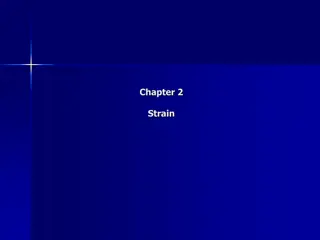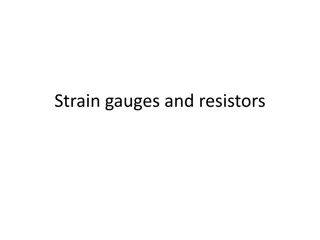Understanding Static GNSS Techniques and Products for Geospatial Applications
This educational material provides insights into static GNSS techniques, products, and their societal benefits. It covers topics such as distinguishing static GNSS techniques, understanding different products, and the capabilities of static GNSS stations. The content explores the Network of the Amer
3 views • 20 slides
BRIDGE EXPANSION JOINT
Bridge expansion joints are crucial components that provide continuity between different parts of bridge structures, accommodating movements caused by various factors like thermal deformation and traffic loads. They come in different types based on movement ranges and construction methods, such as s
5 views • 34 slides
Metal Alloys Forming Operations: Forging, Casting, and More
Metal alloys undergo forming operations like forging, rolling, extrusion, and casting to change their shape through plastic deformation. Hot working and cold working processes are utilized to enhance mechanical properties. Techniques such as sand casting, die casting, and investment casting are empl
0 views • 18 slides
2D Geometric Transformations for Computer Graphics
In this lecture on 2D Geometric Transformations, Assistant Professor Dr. Samsun M. BA ARICI covers topics such as translation, rotation, scaling, homogeneous representations, and coordinates. The lecture delves into basic transformations like reflection and shearing, as well as practical application
2 views • 81 slides
TPC Mechanical Support Considerations for ILD Integration Task Force Meeting
During the ILD Integration Task Force meeting, discussions revolved around the deformation of the TPC under weight and pressure, fixation points for hanging the TPC, considerations for supporting the TPC with the Cryostat or HCAL, and dealing with potential service clashes. Challenges and preference
0 views • 5 slides
Introduction to Properties of Fluids in Hydraulic Systems
Fluids, including liquids and gases, exhibit continuous deformation when subjected to shear forces. Understanding fundamental properties like density, specific weight, and specific volume is crucial for applying fluid mechanics principles to solve practical problems in fluid power systems. This chap
0 views • 34 slides
Understanding Stress-Strain Behavior in Materials
The stress-strain diagram illustrates how materials respond to mechanical forces, showcasing various properties such as elastic limit, yield point, ultimate strength, and rupture strength. By analyzing the curve, engineers can determine the material's behavior under different loads and stresses, aid
0 views • 6 slides
Understanding True Stress and Strain in Materials
In materials engineering, the use of true stress and true strain provides a more accurate representation of material behavior, especially in regions undergoing deformation like necking. True stress considers the instantaneous cross-sectional area, accounting for changes in the material's strength du
0 views • 15 slides
The Economic Impact of Delayed Diagnosis of Axial Spondyloarthritis in the UK
Delayed diagnosis of axial spondyloarthritis in the UK leads to significant physical, emotional, and financial burdens for patients. This research aims to quantify the full economic cost of diagnostic delays, highlighting the need for timely identification and management of this incurable form of in
0 views • 11 slides
Understanding Axial Deformation in Mechanics of Materials
In the study of mechanics of materials, axial deformation is analyzed by simplifying real structural elements. This approach involves approximations that are generally satisfactory and work due to factors like allowable stress design, factor of safety, and statistical analysis of strength. Saint-Ven
0 views • 9 slides
Understanding Typical Damages in Machine Parts and Maintenance Techniques
Sliding bearings and anti-friction bearings are prone to damages such as wear, fatigue, and misalignment. Effective maintenance strategies include checking lubrication, shaft deformation, and overall system alignment. Recognition of common defects and implementing preventative measures like knurling
0 views • 34 slides
The Axial Age: Pivotal Thinkers Across Ancient Civilizations
The Axial Age, coined by Karl Jaspers, refers to a period from the 8th to 3rd century BCE where pivotal thinkers emerged independently in Persia, India, China, Greece, and Rome, shaping the spiritual foundations of humanity. Jaspers, a German philosopher and psychiatrist, highlighted the importance
2 views • 21 slides
Study of Prototype Straw Tube End-cap Technology
The content describes the design and assembly of a 1-meter prototype for straw tube end-cap technology. Details include the structure of the detector layers forming coordinate systems, construction on a rigid flat table, stretching of straw tubes, effects of humidity on tube elongation, and the use
0 views • 11 slides
Antler Orogeny and Foreland Basin Model Overview
The Antler Orogeny, a Late Devonian to mid-Early Mississippian event, impacted the passive margin of the North American continent, particularly in Nevada and Idaho. The orogeny involved displacement of oceanic strata, subsidence of a foreland basin, and maintenance of highlands in the interior regio
1 views • 14 slides
Understanding Forces and Mass
Forces, such as contact and non-contact forces, interact with objects to cause motion or deformation. Mass is the amount of matter in an object, measured in kilograms. Learn about applied force, normal force, frictional force, air resistance, spring force, tensile forces, compressive forces, and she
1 views • 29 slides
Dr. Syed S.H. Rizvi: Professor of Food Science at Cornell University
Dr. Syed S.H. Rizvi is an esteemed International Professor of Food Process Engineering at Cornell University, USA. With a strong background in food science and bioseparation processes, he has made significant contributions to the field through his research, publications, and role as Editor in Chief.
0 views • 15 slides
Significance of Pear-Shaped Nuclei in Atomic Physics
Causes of deformation in atomic nuclei, leading to pear-shaped structures, are explored with examples such as 224Ra and 220Ra. Measurement of Barium isotopes using advanced techniques sheds light on the spatial asymmetry of nuclei. The significance of pear-shaped nuclei in explaining CP-symmetry bre
0 views • 7 slides
Efficient Dynamic Skinning with Low-Rank Helper Bone Controllers
This research explores efficient dynamic skinning methods using low-rank helper bone controllers to achieve robust, simple, and high-performance skin deformation in computer graphics. By investigating linear blend skinning techniques and helper bone rigs, the study aims to address the wishlist of ga
0 views • 29 slides
Steel Design for Combined Forces: AISC Chapter H Summary and Equations
Steel design for members subject to axial force and flexure, addressing doubly and singly symmetric members, interaction of flexure and compression, required axial compressive and flexural strength calculations based on LRFD load combinations. Equations provided for design considerations in AISC Spe
0 views • 27 slides
Laplacian Deformation in Engineering and Applied Science
Laplacian deformation is a technique used in non-rigid registration to account for shape variance and improve fitting between source and target shapes. This method involves minimizing the distance and distortion terms to achieve accurate alignment. Intrinsic and extrinsic methods are discussed, wher
0 views • 53 slides
Advanced Solutions for Concrete Dam Assessment
Utilizing advanced methods for the assessment of existing concrete dams is crucial for ensuring their stability and safety. This project focuses on analyzing the stability of small concrete dams in Norway built between 1950-1970, which may not meet current safety standards. The study involves evalua
0 views • 12 slides
Understanding the Anatomy of the Skeletal System
Explore the two major sections of the skeletal system: the Axial Skeleton, which provides protection to vital organs, and the Appendicular Skeleton, enabling movement. Discover variations in bone structure across species, from horses to dogs, and delve into the bones of the Axial Skeleton, including
0 views • 29 slides
Understanding the Axial and Appendicular Skeleton in Vertebrates
The axial skeleton consists of the bones in the head and trunk, while the appendicular skeleton supports the limbs in vertebrates. The appendicular skeleton aids in locomotion and manipulation, comprising 126 bones in total. Understanding the structure and functions of these skeletal systems is vita
0 views • 23 slides
Elevating Public Health Impact in Axial SpA Awareness
Elevate your impact as a change-maker in Axial Spondyloarthritis (Axial SpA) awareness by implementing a comprehensive strategy spanning levels from Bronze to Platinum. Showcase your involvement, leadership, and sustainable achievements through active participation, engagement, and effective communi
0 views • 5 slides
Carbonates Replacing Plagioclase Glass in Martian Meteorite ALH84001
The carbonates replacing plagioclase glass in the Martian meteorite ALH84001 have raised questions about their origin - whether they are biologically formed or through other geological processes. Discovered in Antarctica in 1984, this meteorite has been dated to over 4 billion years and initially mi
0 views • 14 slides
Understanding Viscous Fluid Behavior in Engineering Applications
Viscosity is a crucial property in fluid mechanics, impacting how fluids deform and move. Engineers measure viscosity using factors like resistance to deformation and fluid behavior classifications such as Newtonian, shear thinning, shear thickening, and Bingham plastic. This knowledge is essential
0 views • 7 slides
Thermal and Mechanical Simulation of Beryllium Window for MICE 201 MHz Cavity
Conducted thermal and mechanical simulations using TEM3P for the beryllium window of the MICE 201 MHz cavity. Analysis focused on temperature distribution, frequency shifts, thermal deformation control, and stress considerations under varying operation conditions and material properties. Detailed in
0 views • 11 slides
Thermal Fatigue of a Surface Mount Resistor: A COMSOL Analysis
A COMSOL analysis is conducted on the thermal fatigue of a surface mount resistor subjected to thermal cycling. The study focuses on the solder joint, structural integrity, and life prediction using fatigue models. Various aspects of the resistor assembly, including material composition, dimensions,
0 views • 13 slides
Understanding Elastic Properties of Materials
Stress and strain are key concepts in understanding the elasticity of materials. Stress is the force acting on an object per unit area, while strain measures the degree of deformation due to stress. Different types of stress include tension, compression, and shear stress. The relationship between st
0 views • 41 slides
Mechanical Behavior of Structures: Stress-Strain Diagrams and Elastic Properties
Understanding the mechanical behavior of structures involves analyzing stress-strain diagrams, distinguishing between ductile and brittle materials, exploring linear and non-linear elastic properties, studying plastic deformation, yield strength, ultimate tensile strength, and toughness. Elastic beh
0 views • 32 slides
Understanding Ametropia: Refractive Eye Conditions Explained
Ametropia refers to refractive errors in the eye such as myopia, hypermetropia, and astigmatism, where light rays don't focus correctly on the retina. This condition is influenced by corneal power, anterior chamber depth, crystalline lens power, and axial length. Hypermetropia, also known as hyperop
0 views • 25 slides
Understanding Aeroelasticity: Deformation and Aerodynamic Forces
Aeroelasticity explores the intricate relationship between the deformation of elastic structures in an airstream and the resulting aerodynamic forces. This field of study is vital for predicting and managing interactions between structural mechanics and aerodynamics in aircraft design. Historical in
0 views • 15 slides
Understanding Ankylosing Spondylitis: Causes, Symptoms, and Pathogenesis
Ankylosing spondylitis (AS) is an inflammatory disorder that primarily affects the axial skeleton. The disease causes pain, stiffness, and decreased spinal mobility, and it can lead to disability and decreased quality of life. AS is an autoimmune disease with a complex pathogenesis involving interac
0 views • 32 slides
Basics of Metal Forming Processes
Metal forming processes play a crucial role in shaping products, with casting, machining, joining, and deformation being the primary methods. Each process has its advantages and limitations, catering to different needs for accuracy, material wastage, complexity, and production quantities. Understand
0 views • 22 slides
Understanding Crust Deformation: Forces, Stress, and Isostatic Adjustments
The Earth's crust undergoes various forms of deformation such as bending, tilting, and breaking due to forces like compression, tension, and shearing. Isostatic adjustments play a role in areas with mountain ranges, causing the crust to bend up and down. As mountain ranges erode, the crust lightens
0 views • 9 slides
Understanding Cyclohexane Conformational Analysis
Conformational analysis of cyclohexane involves studying its chair form, axial and equatorial bonds, ring-flipping process, and stability comparison between chair and boat forms. The ring-flipping process interconverts axial and equatorial hydrogens, resulting in a more stable chair conformation. Vi
0 views • 21 slides
Understanding Displacement, Deformation, and Normal Strain in Mechanics of Materials
Displacement and deformation in materials play a crucial role when loads are applied, leading to normal strain. This lecture discusses the concepts of displacement, deformation, and strain, covering topics such as types of strain, strain units, normal strain calculations, and the orientation of norm
0 views • 7 slides
Understanding Deformation and Strain in Engineering
Deformation occurs when a force is applied to a body, causing changes in its shape and size. Normal strain refers to the elongation or contraction of a line segment per unit length, while shear strain is the change in angle between two originally perpendicular line segments. Cartesian strain compone
0 views • 6 slides
Understanding Speckle Tracking Echocardiography Basics
Speckle tracking echocardiography is a method analyzing speckle artifacts in ultrasound images to obtain information on myocardial motion and deformation. By tracking speckles in the ventricle wall, parameters like motion displacement, velocity, strain, and strain rate can be measured. Deformation c
1 views • 12 slides
Understanding Strain Gauges and Deformation in Beams
Explore the concepts of strain gauges and resistors, how loading deforms beams, and Da Vinci's insights on spring bending. Learn about axial strain measurement, strain proportional to resistance change, bridge circuits, and formulas for cantilever beams. Understand the importance of strain gauge att
0 views • 9 slides


